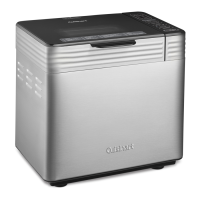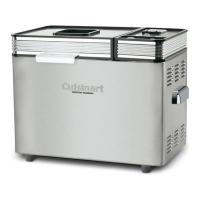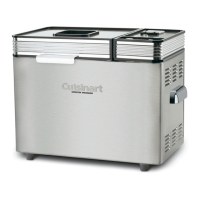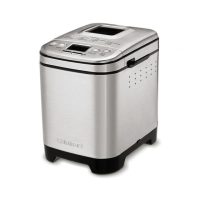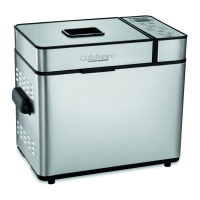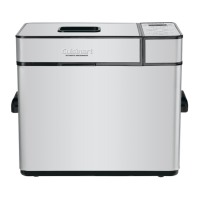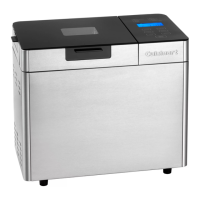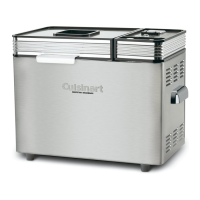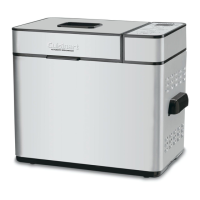14 15
BREAD PAN CARE
If preparing gluten-free, low carb, or cake/quick breads, lightly coat the bread pan and paddle with a flavourless oil,
such as vegetable or grapeseed. Do not use canned nonstick cooking spray as it may reduce the effectiveness of
the nonstick coating over time.
Scrape down the pan if ingredients are sticking to the sides.
KNEADING/MIXING PROCESS
While the Cuisinart
®
Custom Convection Bread Maker provides a hands-off process, we recommend checking
on the dough as it is going through the first kneading/mixing process. This first step of the kneading will make
it clear if the dough needs additional water (it is not mixing in all of the dry ingredients fully), flour (it is very
sticky, not really kneading well), or just needs to be scraped down (often the case with gluten free, low carb,
and cake/quick breads). Add just 1 teaspoon (5 ml) at a time of either water or the appropriate flour if either
of those issues is occurring. The mixing/kneading process will not be affected by opening the lid to check in
on the dough.
When making traditional yeasted breads, it's good to press your finger into the dough a couple of times. If it
feels too dense, add an additional teaspoon or two of water to the pan. If the dough sticks to your finger then
add a teaspoon of flour. These steps early on will lead to a better loaf in the end!
Ambient temperature and humidity affect bread-maker baking, and these factors can be the reason for
inconsistent results. On a humid day, you may need additional flour. Pay attention to the dough during the first
kneading cycle and if sticky, add flour 1 teaspoon (5 ml) at a time. Alternately, if it is especially dry, you may
need to add additional liquid.
SHAPING YEASTED DOUGH TO BE BAKED IN THE UNIT
When preparing breads using any of the traditional yeasted bread programs, there is the option of removing
the paddle before the final rise cycle and bake. This creates a more even rise and uniform loaf of bread. When
the tone alerts to do so, remove the kneading paddle and reshape the dough into a neat loaf, being sure
the top and sides of the bread are nice and smooth. We recommend always removing the bread paddle and
shaping the dough when preparing 1-pound (454 g) yeasted loaves.
SLICING, SERVING, AND STORING BREAD
Allow breads to cool for a minimum of 30 minutes before slicing and serving.
Store bread well wrapped at room temperature for up to 2 days.
For longer storage, wrap tightly and freeze.
HIGHER ALTITUDES
Flour is drier at higher altitudes and will absorb more liquid, so use less flour in the recipe. Pay attention
to the dough as it mixes and kneads. If it appears dry, add more of the same liquid used in the recipe.
Doughs prepared and baked at higher altitudes will tend to rise faster. Use about one-third less yeast
to help counteract this phenomenon.
Adding less sugar (where applicable) also helps in producing the proper dough and bread.
Reduce sugar or sweetener by about one-fourth.
Start with one of these changes to determine the best results.

